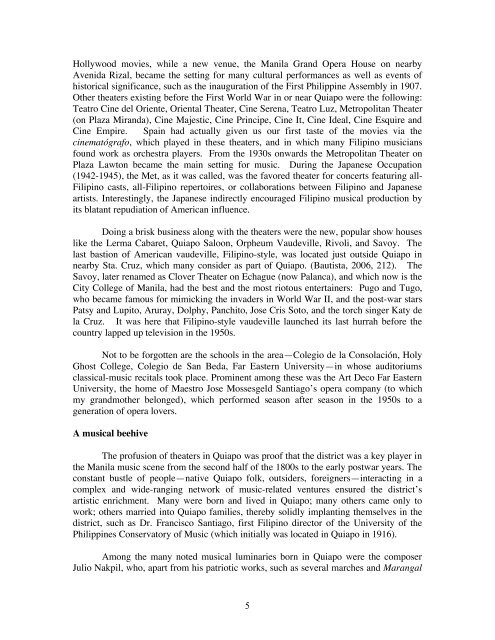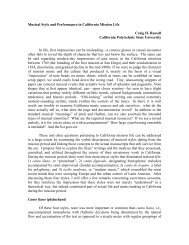Music in The Heart of Manila - Center for Iberian and Latin American ...
Music in The Heart of Manila - Center for Iberian and Latin American ...
Music in The Heart of Manila - Center for Iberian and Latin American ...
Create successful ePaper yourself
Turn your PDF publications into a flip-book with our unique Google optimized e-Paper software.
Hollywood movies, while a new venue, the <strong>Manila</strong> Gr<strong>and</strong> Opera House on nearby<br />
Avenida Rizal, became the sett<strong>in</strong>g <strong>for</strong> many cultural per<strong>for</strong>mances as well as events <strong>of</strong><br />
historical significance, such as the <strong>in</strong>auguration <strong>of</strong> the First Philipp<strong>in</strong>e Assembly <strong>in</strong> 1907.<br />
Other theaters exist<strong>in</strong>g be<strong>for</strong>e the First World War <strong>in</strong> or near Quiapo were the follow<strong>in</strong>g:<br />
Teatro C<strong>in</strong>e del Oriente, Oriental <strong>The</strong>ater, C<strong>in</strong>e Serena, Teatro Luz, Metropolitan <strong>The</strong>ater<br />
(on Plaza Mir<strong>and</strong>a), C<strong>in</strong>e Majestic, C<strong>in</strong>e Pr<strong>in</strong>cipe, C<strong>in</strong>e It, C<strong>in</strong>e Ideal, C<strong>in</strong>e Esquire <strong>and</strong><br />
C<strong>in</strong>e Empire. Spa<strong>in</strong> had actually given us our first taste <strong>of</strong> the movies via the<br />
c<strong>in</strong>ematógrafo, which played <strong>in</strong> these theaters, <strong>and</strong> <strong>in</strong> which many Filip<strong>in</strong>o musicians<br />
found work as orchestra players. From the 1930s onwards the Metropolitan <strong>The</strong>ater on<br />
Plaza Lawton became the ma<strong>in</strong> sett<strong>in</strong>g <strong>for</strong> music. Dur<strong>in</strong>g the Japanese Occupation<br />
(1942-1945), the Met, as it was called, was the favored theater <strong>for</strong> concerts featur<strong>in</strong>g all-<br />
Filip<strong>in</strong>o casts, all-Filip<strong>in</strong>o repertoires, or collaborations between Filip<strong>in</strong>o <strong>and</strong> Japanese<br />
artists. Interest<strong>in</strong>gly, the Japanese <strong>in</strong>directly encouraged Filip<strong>in</strong>o musical production by<br />
its blatant repudiation <strong>of</strong> <strong>American</strong> <strong>in</strong>fluence.<br />
Do<strong>in</strong>g a brisk bus<strong>in</strong>ess along with the theaters were the new, popular show houses<br />
like the Lerma Cabaret, Quiapo Saloon, Orpheum Vaudeville, Rivoli, <strong>and</strong> Savoy. <strong>The</strong><br />
last bastion <strong>of</strong> <strong>American</strong> vaudeville, Filip<strong>in</strong>o-style, was located just outside Quiapo <strong>in</strong><br />
nearby Sta. Cruz, which many consider as part <strong>of</strong> Quiapo. (Bautista, 2006, 212). <strong>The</strong><br />
Savoy, later renamed as Clover <strong>The</strong>ater on Echague (now Palanca), <strong>and</strong> which now is the<br />
City College <strong>of</strong> <strong>Manila</strong>, had the best <strong>and</strong> the most riotous enterta<strong>in</strong>ers: Pugo <strong>and</strong> Tugo,<br />
who became famous <strong>for</strong> mimick<strong>in</strong>g the <strong>in</strong>vaders <strong>in</strong> World War II, <strong>and</strong> the post-war stars<br />
Patsy <strong>and</strong> Lupito, Aruray, Dolphy, Panchito, Jose Cris Soto, <strong>and</strong> the torch s<strong>in</strong>ger Katy de<br />
la Cruz. It was here that Filip<strong>in</strong>o-style vaudeville launched its last hurrah be<strong>for</strong>e the<br />
country lapped up television <strong>in</strong> the 1950s.<br />
Not to be <strong>for</strong>gotten are the schools <strong>in</strong> the area—Colegio de la Consolación, Holy<br />
Ghost College, Colegio de San Beda, Far Eastern University—<strong>in</strong> whose auditoriums<br />
classical-music recitals took place. Prom<strong>in</strong>ent among these was the Art Deco Far Eastern<br />
University, the home <strong>of</strong> Maestro Jose Mossesgeld Santiago’s opera company (to which<br />
my gr<strong>and</strong>mother belonged), which per<strong>for</strong>med season after season <strong>in</strong> the 1950s to a<br />
generation <strong>of</strong> opera lovers.<br />
A musical beehive<br />
<strong>The</strong> pr<strong>of</strong>usion <strong>of</strong> theaters <strong>in</strong> Quiapo was pro<strong>of</strong> that the district was a key player <strong>in</strong><br />
the <strong>Manila</strong> music scene from the second half <strong>of</strong> the 1800s to the early postwar years. <strong>The</strong><br />
constant bustle <strong>of</strong> people—native Quiapo folk, outsiders, <strong>for</strong>eigners—<strong>in</strong>teract<strong>in</strong>g <strong>in</strong> a<br />
complex <strong>and</strong> wide-rang<strong>in</strong>g network <strong>of</strong> music-related ventures ensured the district’s<br />
artistic enrichment. Many were born <strong>and</strong> lived <strong>in</strong> Quiapo; many others came only to<br />
work; others married <strong>in</strong>to Quiapo families, thereby solidly implant<strong>in</strong>g themselves <strong>in</strong> the<br />
district, such as Dr. Francisco Santiago, first Filip<strong>in</strong>o director <strong>of</strong> the University <strong>of</strong> the<br />
Philipp<strong>in</strong>es Conservatory <strong>of</strong> <strong>Music</strong> (which <strong>in</strong>itially was located <strong>in</strong> Quiapo <strong>in</strong> 1916).<br />
Among the many noted musical lum<strong>in</strong>aries born <strong>in</strong> Quiapo were the composer<br />
Julio Nakpil, who, apart from his patriotic works, such as several marches <strong>and</strong> Marangal<br />
5




